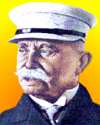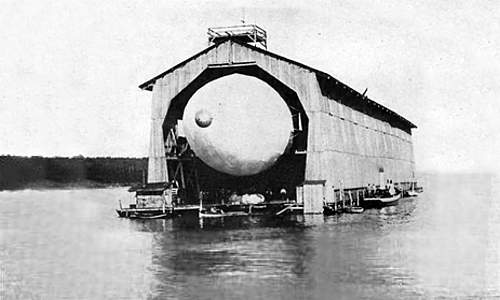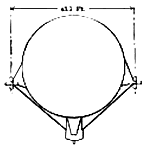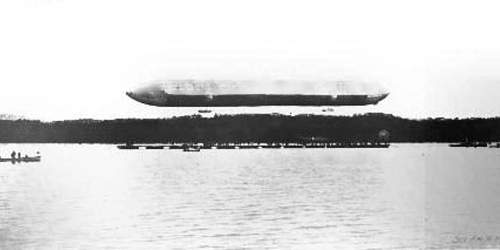 (source)
(source)
|
Count Ferdinand von Zeppelin
(8 Jul 1838 - 8 Mar 1917)
German inventor, engineer and manufacturer who was the aviation pioneer that built the first rigid dirigible airships, named Zeppelins.
|
THE FIRST TWO TRIAL TRIPS OF VON ZEPPELIN’S AIRSHIP.
from Scientific American Supplement (1900)

[p.54] The second day of July will long be remembered by aeronauts, for on that day occurred the first ascension of the great airship just completed by Count von Zeppelin, the cavalry officer of Württemberg who has so long been superintending the construction of his balloon in a huge floating house on Lake Constance.

Count Zeppelin, like all originators of great schemes, has had many unexpected difficulties to contend with, not the least of which was, probably, a tempest which tore his great floating house from its moorings and did other damage, which was repaired only at great expense of time and labor as well as of money. Numerous other accidents interfered with the ascension of his balloon, but finally June 30 was officially given out as the date of the first trial. On that day thousands of people gathered on the shores of the lake, and the water was covered by a fleet that included craft of all kinds, from the fisherman’s primitive boat to the most modern private steam yacht and launch. The crowd was doomed to disappointment, however, for the inflation of the airship was not completed and no ascent could be made. Toward night of the second day the raft on which the airship rested was towed out of the floating house. Even on the third day it seemed doubtful for some time whether any ascension could be made, but finally, the last rope was cut at three minutes after eight, the sliding weight was quickly regulated, and the airship began to move, trying to rise in a graceful curve, which, however, was interrupted at a height of about 150 feet by what seemed to be a rather strong current of air, but it is said that the line connected with the sliding weight became entangled with a line from one of the side propellers. The ship was carried along with the wind in the direction of Immenstadt, where it descended to the water at 8:20. having attained a height of something over 1,300 feet and covered a distance of three and a half miles, traveling with the wind, at a speed of 26 feet per second. During this trial trip von Zeppelin occupied the forward car with an amateur, Mr. von Bassus, of Munich, and an engineer, while in the rear car were the African explorer. Eugen Wolf, and a machinist.
Although all the hopes and expectations of the promoters and friends of the enterprise were not realized, the results obtained were interesting and important, and, as far as the ascent and descent were concerned, entirely satisfactory; but it was evident that the amount of energy developed by the propellers was insufficient. Instead of the promised speed of over 30 feet per second, a speed of only 26 feet per second was really obtained.
The second trial was made on October 17, and was far more successful than the attempt of July 2.
Leaving the balloon house at Manzell at a quarter of five o'clock, the ship immediately rose to a height of about 300 meters (984 feet), and traveled fairly regularly eastward with the east-northeast wind as far as Meersburg, a distance of 11 kilometers (6·8 miles). It then made a wide detour and headed again for Manzell. But the night was growing apace, and the flying machine саmе down in the lake at five minutes past six.
The occupants of the first car were Count von Zeppelin, Lieutenant von Crogh, and Engineer Burr, and of the second, Herr Eugen Wolf and Engineer Gross.
A dispatch to The London Standard from Friedrichshafen says that when the airship rose the wind was from the northeast, blowing with a velocity of three and one-half yards a second. When the airship had attained a height of 400 yards, it described a circle and then drove with the wind in a generally circular direction for about six miles. It then again described a circle, after which it made headway against the wind, which was then blowing with increased velocity. Eventually the airship descended with great ease and steadiness into the lake. The experiment was most successful. The airship’s stability, equilibrium and steering powers were excellent.

Von Zeppelin’s ship consists of a colossal aluminium frame, 416 feet in length, 38 feet in diameter, which, in cross-section, is a twenty-four sided polygon. The cross-sectional area of the balloon body is only 1114·72 square feet, and the entire air-resisting surface, projected upon a vertical plane, has an area of 1188·87 square feet.
The frame is composed of aluminium trellis work, covered with a fabric of which the upper surface is composed of pegamoid, and the under surface of silk. A netting of ramie fiber, which covers all the metal construction, protects this double envelope from injury by the wire framework. The body of the balloon is divided into seventeen compartments, each of which is designed to contain a gas-bag. Of these compartments, fifteen are 26 feet long, and the remaining two 13 feet long. The gas-bags are likewise protected from injury by ramie netting. Above and below the front portion of the balloon body and at each side of the rear portion, rudders are located. The two four-bladed screw-propellers are mounted at each side of the balloon body, at a height approximately equal to that of the center of air resistance. Each propeller has a diameter of 3·77 feet, and a speed of 1,100 revolutions per minute. The propellers, it was thought after the first trial, were not large enough. Whether they have been taken out and others substituted can not as yet be ascertained.
The merit of this compartment construction is evident enough. Although it increases the weight considerably, it tends to preserve longitudinal stability; for the shifting of the gas caused by oscillation of the longitudinal axis is confined to very small spaces and is, therefore, rendered almost inappreciable.

Six and one-half feet below the balloon body, and rigidly connected therewith, is an aluminium platform or bridge, 301·76 feet long, connecting two aluminium cars, each containing a 16 horse power motor and a 23·778 gallon tank, holding sufficient benzine for a run of ten hours. Beneath the airship a rope is suspended (omitted in Fig. 3) upon which a sliding weight (220 pounds) is carried, which can be adjusted to keep the ship in proper longitudinal trim.
Comparing the ever memorable airship of Renard and Krebs, which had a maximum cross-sectional area of 595·225 square feet, with von Zeppelin’s balloon, we find that the cross-sectional area of the latter is 193 times greater. The experiments of Renard-Krebs and of Tissandier proved that the actual velocities attained by airships were proportional to the cubic roots of their motive powers, acting upon the same cross-sectional area. For a cross-sectional area of 100 square meters, 29 horse power of the total 32 will be available for von Zeppelin’s balloon; in the airship of Renard and Krebs, 14·87 horse power were necessary for a speed of 6·5 meters per second. Hence the theoretical speed of von Zeppelin’s airship should be :
v = 6·5 × ∛(29 / 14·87) = 8·12 m. (30·6336 feet) per second.
In this calculation we have not considered factors in favor of Zeppelin's airship, such, for example, as the form and rigidity of the resisting surfaces, the lateral arrangement of the screws at about the height of the central point of resistance. The actual speed obtained on the first trial was but 26 feet per second; but the experiment was by no means conclusive. It is to be hoped that the speed obtained in the second trial more fully realizes the inventor's expectations.
The question naturally arises: How great must be the power to drive a vessel with the 110·449 square meters (1188·87 square feet) maximum cross-sectional area of von Zeppelin's airship? The most trustworthy formula applicable to the problem is that of Ritter von Loessl, which reads:
R = (8/g) × F v² sin α.
In this equation R = resistance of the air to an inclined surface; g = acceleration of gravity (980·94 centimeters per second) ; F = the area of the surface in square meters; v = the relative velocity in meters per second of the resisting surface in air ; α = the inclination of the surface to the horizontal. Roughly substituting von Zeppelin’s quantities in von Loessl's formula, we obtain : R = (1/10) .110.8² sin 30° = 352 kilogrammes wind pressure. Hence we obtain for the energy necessary to drive the ship at an approximate speed of 8 meters per second, 352 x 8 = 2816 kilogramme-meters = 20368·73 foot pounds, which divided by 550 gives approximately 87 horse power.
In this computation the favorable form of the nose has not been considered. Since in the Renard-Krebs airship the calculated horse power was found to be considerably in excess of that actually required, von Zeppelin was justified in assuming that 32 horse power would be amply sufficient.
The weight of both motors is 1,430 pounds; the hourly consumption of fuel, about 26·4 pounds. Since the ballast of the airship will consist entirely of water, the cooling water need not be added to the weight of the motors. The total weight of von Zeppelin’s motors is therefore reduced to 45·54 pounds per horse power hour. The driving shaft is geared to two diagonal shafts which drive the propellers.
The balloon body of von Zeppelin's airship contains 11,300 cubic meters (399,059·5 cubic feet) of gas and consequently has a lifting capacity of 10 tons. From calculations which have been made, the total weight, including the crew, is equal to 10,000 kilogrammes (9 tons), leaving 1 ton as a remainder.
[p.55] At the previously mentioned speed of 8·12 meters per second, 288 kilometers or 179 miles will be the normal radius of the ship. But since the lifting capacity is such that 800 to 1,000 additional pounds of benzine can be carried, the ship can readily journey from thirty to forty hours, so that its radius will be considerably increased.
[In Fig.1, by looking closely at the small steamboat docked along the right side of the hangar you can see to the left of its funnel there are two people which help scale the true size of the dirigible. Labels in Fig. 3 are: 420 ft., Rudders, Rudders, Propeller, Propeller, Car and Motor, Platform, Car and Motor.]
[Pegamoid is a former trademark for a waterproof varnish applied to surfaces such as airplane cloths and waterproof fabrics for coats. An article titled “Pegamoid” in United States Investor (26 Mar 1898, vol. 9, p.465), quotes the official company description of the process as “the application, in liquid form, of a composition, which, by impregnating the fibres or pores of the substances treated has the effect of water-proofing. strengthening, sterilizing, and generally protecting the material used. It can be applied to all cloths made from cotton, wool. silk, flax. jute, hemp, ramie, or other fibres; to all kinds of paper—including wall papers; to hides or skins, and in the form of paint—to all iron, steel, wood and stone work. Articles subjected to this process are rendered stronger, more durable and useful. They are absolutely rot and damp proof, and are unaffected by changes of temperature or climate, while in many cases the cost is materially reduced.”]
[Ramie, also known as China grass, is a linen-like fabric spun or woven from the strong bast fibres of the ramie plant. This herbaceous perennial, of the nettle family Urticaceae, is native to eastern Asia. It is one of most ancient vegetable fibres used to weave fabrics, and was used in mummy cloths in Egypt as early as 5000 BC. When processed, the plant yields cellulose fibres that are very fine like silk. The modern fabric industry may use ramie blended with cotton to make woven and knit fabrics, as in tablecloths or sweaters. It is also used in fish nets, upholstery fabrics and fire hoses.]
- Science Quotes by Count Ferdinand von Zeppelin.
- 8 Jul - short biography, births, deaths and events on date of Zeppelin's birth.
- 2 Jul - births, deaths and events on date of the first Zeppelin test flight.
- Zeppelin: The Story of a Great Achievement, by Harry Vissering. - book suggestion.
- Booklist for Ferdinand Zeppelin.




